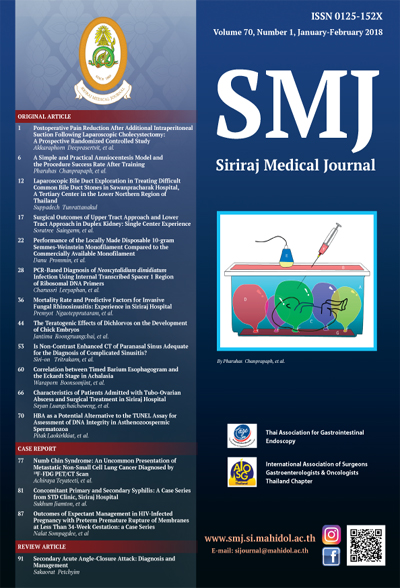PCR-Based Diagnosis of Neoscytalidium dimidiatum Infection Using Internal Transcribed Spacer 1 Region of Ribosomal DNA Primers
Keywords:
Neoscytalidium dimidiatum; N. dimidiatum infection; N.dimidiatum-specific primers; PCR-based diagnosis; nondermatophytesAbstract
Objective: To develop N. dimidiatum-specific single PCR-based identification with DNA sequences of nuclear ribosomal internal transcribed spacer (ITS) 1 region primers to facilitate the rapid and accurate detection of N. dimidiatum.
Methods: N. dimidiatum-specific PCR primers were designed based on the sequence of the internal transcribed spacer 1 region, which is located between 18S and 5.8S nuclear rDNA. Fungal DNA extracted from common causative species for superficial fungal infection including: 2 strains of N. dimidiatum, 9 species of dermatophyte (DMP) and 25 species of non-dermatophyte (NDM) colonies grown on culture plates were used for PCR analysis. Also, 30 clinical specimens collected from 30 patients clinically diagnosed with fungal nail and feet infection who attended Dermatology clinic Siriraj Hospital during October 2015 to November 2015 were used for PCR assay.
Results: Using N. dimidiatum-specific PCR primers, the PCR product was amplified from two standard strains of N. dimidiatum, and there was no amplification from other DMP or NDM species. Regarding sensitivity as lower limit of detection, this PCR method was able to detect 10 pg of N. dimidiatum DNA with ethidium bromide staining and could detect N. dimidiatum in clinical samples.
Conclusion: This newly developed N. dimidiatum-specific PCR identification system is rapid, sensitive, and specific. This diagnostic method will facilitate early and accurate diagnosis and accelerate appropriate treatment in patients with N. dimidiatum infection.
Downloads
Published
How to Cite
Issue
Section
License
Authors who publish with this journal agree to the following conditions:
Copyright Transfer
In submitting a manuscript, the authors acknowledge that the work will become the copyrighted property of Siriraj Medical Journal upon publication.
License
Articles are licensed under a Creative Commons Attribution-NonCommercial-NoDerivatives 4.0 International License (CC BY-NC-ND 4.0). This license allows for the sharing of the work for non-commercial purposes with proper attribution to the authors and the journal. However, it does not permit modifications or the creation of derivative works.
Sharing and Access
Authors are encouraged to share their article on their personal or institutional websites and through other non-commercial platforms. Doing so can increase readership and citations.











